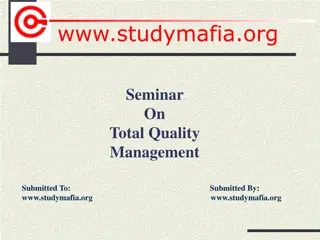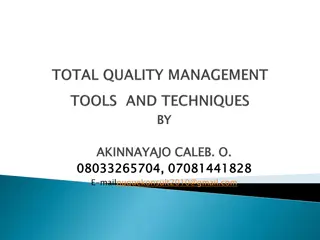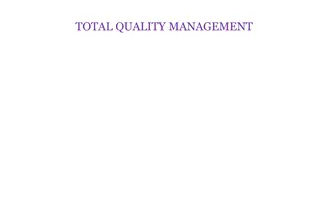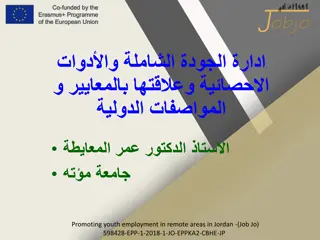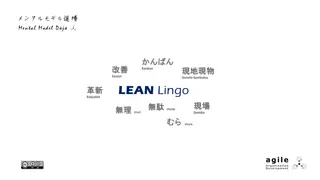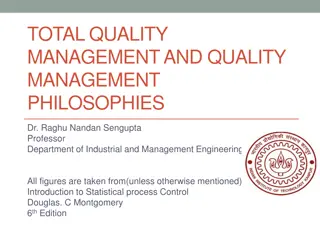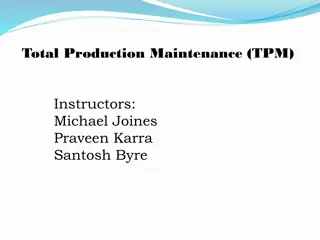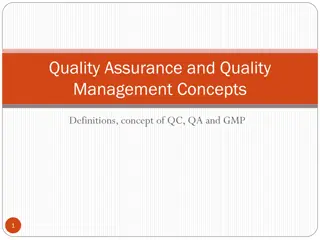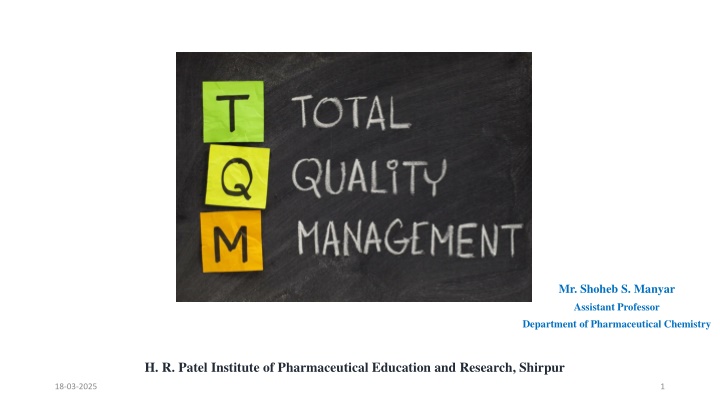
Total Quality Management (TQM) in the Pharmaceutical Industry
Explore the principles, advantages, and importance of Total Quality Management (TQM) in the pharmaceutical sector. Learn about the background, key elements, and philosophy of TQM, focusing on achieving excellence through customer satisfaction and continuous improvement. Discover how TQM ensures efficiency, quality, and success for organizations.
Uploaded on | 1 Views
Download Presentation

Please find below an Image/Link to download the presentation.
The content on the website is provided AS IS for your information and personal use only. It may not be sold, licensed, or shared on other websites without obtaining consent from the author. If you encounter any issues during the download, it is possible that the publisher has removed the file from their server.
You are allowed to download the files provided on this website for personal or commercial use, subject to the condition that they are used lawfully. All files are the property of their respective owners.
The content on the website is provided AS IS for your information and personal use only. It may not be sold, licensed, or shared on other websites without obtaining consent from the author.
E N D
Presentation Transcript
Mr. Shoheb S. Manyar Assistant Professor Department of Pharmaceutical Chemistry H. R. Patel Institute of Pharmaceutical Education and Research, Shirpur 18-03-2025 1
Content: Background of TQM Elements of TQM Principles of TQM Advantages & Disadvantages of TQM Importance of TQM in pharma industry Functions of TQM Philosophy of TQM 18-03-2025 2
What is TQM? Total: Made up of the whole or Complete Quality: Degree of excellence (A product or service provides to the customer in present and future) Management: Act, Art or manner of handling, controlling, directing etc. TQM: is the art of managing the whole to achieve excellence. 18-03-2025 3
BACKGROUND Concepts developed in Japan beginning in the late 1940's and 1950's, pioneered there by W. Edwards Deming, Armand V. Feigenbaum and Joseph M. Juran, jointly developed the concept of TQM. The evolution of TQM happened in a few stages easily identified as Inspection, Quality Control, Quality Assurance and now Total Quality Management. Initially, TQM was originated in the manufacturing sector but it could be applied to all organizations. TQM is a management approach for an organization, depending upon the participation of all its members (including its employees) and aiming for a long-term success of work culture, services, systems, processes and so on to ensure a continuing through customer satisfaction. 18-03-2025 4
TQM TQM is a management approach for an organization, centred on quality, based on the participation of all its members and aiming at long-term success through customer satisfaction, and benefits to all members of the organization and to society. It is an customer-oriented process and aims for continuous improvement of business operations. It ensures that all allied works (particularly work of employees) are toward the common goals of improving product quality or service quality, as well as enhancing the production process or process of rendering of services. 18-03-2025 5
ELEMENTS OF TOTAL QUALITY MANAGEMENT (TQM) There are Eight Key elements of TQM these elements can be divided into four groups according to their function Foundation: Ethics, Integrity and Trust Building Bricks: Training, Teamwork and Leadership Binding Mortar: Communication Roof: Recognition 18-03-2025 6
ELEMENTS OF TOTAL QUALITY MANAGEMENT (TQM) Ethics Integrity Trust Training Recognition TQM Communication Teamwork Leadership 18-03-2025 7
ELEMENTS OF TOTAL QUALITY MANAGEMENT (TQM) 1. ETHICS Ethics is concerned with good and bad in any situation. It is two faceted subject represented by organizational and individual ethics. Ethics teach an individual/employee to follow code of conduct of organization and adhere to rules and regulations. 2. INTEGRITY Integrity implies honesty, morals, values, fairness and adherence to the facts and sincerity. You need to respect your organization's policies. Avoid spreading unnecessary rumors about your fellow workers. Total Quality Management does not work in an environment where employees criticize and backstab each other. 18-03-2025 8
Cont 3. TRUST Trust is one of the most important factors necessary for implementation of total quality management. Employees need to trust each other to ensure participation of each and every individual. Trust improves relationship among employees and eventually helps in better decision making which further helps in implementing total quality management successfully. 4. TRAINING Managers need to make their fellow workers aware of the benefits of total quality management and how would it make a difference in their product quality and eventually yield profits for their organization. Employees need to be trained on interpersonal skills, the ability to work as a team member, technical know-how, decision making skills, problem solving skills and so on. 18-03-2025 9
Cont 5. TEAMWORK To become successful in business team work is a key element. With the use of teams, the business will receive quicker and better solutions to problem. Team also provides more permanent improvements in processes and operations. There are three types of teams that organizations adopt: 1. Quality improvement team or excellence team These are the temporary teams with the purpose of dealing with specific problems that often re-occur. 2. Problem solving team These are temporary teams to solve certain problems and also to identify and overcome the causes of problem. 3. Natural working team These teams consist of small group of skilled workers who share tasks and responsibilities. 18-03-2025 10
Cont 6. LEADERSHIP It is the most important element in TQM It appears everywhere in organization Total Quality Management needs to have a supervisor who acts as a strong source of inspiration for other members and can assist them in decision making 18-03-2025 11
Cont 7. COMMUNICATION It binds everything together, starting from foundation to roof of TQM. It acts as a vital link between all elements of TQM. Communication means a common understanding of ideas between the sender and receiver. The success of TQM demands communication with and among all the organizational members, suppliers and customers. There are different ways of communication 1. Downward communication: This is the dominant form of communication in an organization, in this flow of information takes place from the management to the employees. 2. Upward communication: By this lower level of employees are able to provide suggestions to upper management, in this flow of information takes place from the employees to the top level management. 18-03-2025 12
Cont 8. RECOGNITION Recognition is the final element of Total Quality Management. Recognition is the most important factor which acts as a catalyst and drives employees to work hard as a team and deliver their lever best. Every individual is hungry for appreciation and recognition. Employees who come up with improvement ideas and perform exceptionally well must be appreciated in front of all. 18-03-2025 13
THE KEY PRINCIPLES OF TOTAL QUALITY MANAGEMENT 18-03-2025 14
1. Customer focus When you understand what your customer wants or needs, you have a better chance of figuring out how to get the right materials, people, and processes in place to meet and exceed their expectations. To implement this TQM principle: Research and understand your customers needs and expectations. Align your organization s objectives with customer needs. Communicate with customers, measure satisfaction, and use the results to find ways to improve processes. Find a balance for satisfying customers and other interested parties (such as owners, employees, suppliers, and investors). The benefits of being customer-focused include: More sales, increased revenue, market share. Strong customer loyalty leading to repeat business Increased possibility that satisfied customers will tell others about your products and services 15 18-03-2025
2. Total employee commitment You can t increase productivity, processes, or sales without the total commitment of all employees. They need to understand the vision and goals that have been communicated. They must be sufficiently trained and given the proper resources to complete tasks in order to be committed to reaching goals on time. To implement this TQM principle: Clearly communicate and acknowledge the importance of each individual contribution to the completed product. Acknowledge successes and optimized performance to build confidence in your employees and your stakeholders. Make responsibilities clear, provide adequate training, and make sure your resources are used as efficiently as possible. Create an environment where employees can openly discuss problems and suggest ways to solve them. 18-03-2025 16
Cont The key benefits of total employee commitment include: Increased employee retention because employees are motivated, committed, and actively involved in working toward customer satisfaction Individual and team innovation and creativity in problem-solving and process improvement Enthusiasm for active participation and contribution to continual improvement 18-03-2025 17
3. Process approach Adhering to processes is critical in quality management. Processes ensure that the proper steps are taken at the right time to ensure consistency and speed up production. To implement this TQM principle: Use Total Quality Management tools such as process flowcharts to define and delineate clear roles and responsibilities so everybody knows who does what at certain times. Create a visual action plan so everybody can easily see the specific activities that need to be completed to achieve the desired result. Benefits of a process approach include: Faster development and production cycles, lower costs, and increased revenue More consistency and predictable outcomes Focus on continued improvements and success 18-03-2025 18
4. Integrated system Typically a business has many different departments, each with their own specific functions and purposes. These departments and functions should be interconnected with horizontal processes that should be the focus of Total Quality Management. In an integrated system, everybody in every department should have a thorough understanding of policies, standards, objectives, and processes. To implement this TQM principle: Promote a work culture focused on quality. Use flowcharts and other visual aids to help employees understand how their functions fit in with the rest of the company. Make training available for employees who need to learn new processes and who want to explore opportunities for advancement. 18-03-2025 19
5. Strategic and systematic approach The International Organization for Standardization (ISO) describes this principle as: Identifying, understanding and managing interrelated processes as a system contributes to the organization s effectiveness and efficiency in achieving its objectives. To implement this TQM principle: Provide your people with the proper training and resources that will help them complete their individual steps in the process. Continually improve processes and products, and upgrade equipment as necessary to reach goals. Make continual improvement a measurable objective for all employees. Recognize, acknowledge, and reward innovations and process improvements. Benefits include: An ability to quickly identify, react, and fix process Overall improved organizational capabilities and improved performance 18-03-2025 20
6. Continual improvement Optimal efficiency and complete customer satisfaction doesn t happen in a day your business should continually find ways to improve processes and adapt your products and services as customer needs shift. To implement this TQM principle: Implement policies to establish product, process, and system improvements as measurable goals for individuals, teams, and departments. Recognize, acknowledge, and encourage innovation to improve processes and development. Encourage employees to participate in available training sessions to learn and take on new and additional roles. Benefits include: Improved knowledge and capabilities to increase performance Improvement goals strategically aligned with organizational capabilities 18-03-2025 21
7. Fact-based decision-making Analysis and data gathering lead to better decisions based on the available information. Making informed decisions leads to a better understanding of customers and your market. To implement this TQM principle: Analyze and check data to ensure that it is reliable and accurate. Make relevant data available to stakeholders. Use valid methods to gather and analyze data. Benefits include: Ability to make informed decisions Ability to analyze and defend past decisions by referencing factual records Ability to change past decisions based on data review 18-03-2025 22
8. Communications Everybody in your organization needs to be aware of plans, strategies, and methods that will be used to achieve goals. There is a greater risk of failure if you don t have a good communication plan. To implement this TQM principle: Establish an official line of communication so that all employees know about updates, policy changes, and new processes. Where possible, involve employees in decision-making. Make sure everybody in every department understands their roles and how they fit in with the rest of the company. Benefits include: Boost in morale and motivation when employees understand how their contributions help the company achieve its goals Interdepartmental coordination and cooperation 18-03-2025 23
The principles of the TQM are as follows 1. Commitment from the management: Plan (drive, direct) Do (deploy, support, and participate) Check (review) Act (recognize, communicate, revise) THE KEY PRINCIPLES OF TOTAL QUALITY MANAGEMENT 18-03-2025 24
Cont 2. Employee Empowerment Training Excellence team Measurement and recognition Suggestion scheme 18-03-2025 25
Cont 3. Continuous Improvement Systematic measurement Excellence team Cross-functional process management Attain, maintain, improve standards 4. Customer Focus Partnership with Suppliers Service relationship with internal customers Fig. TQM in pharma Industries Customer-driven standards Never compromise quality 18-03-2025 26
ADVANTAGES OF TQM Improves reputation- faults and problems are spotted and sorted quicker Higher employee morale- workers motivated by extra responsibility, team work and involvement in decisions of TQM Lower cost-decreasewaste as fewer defective products and no need for separate Quality control inspector DISADVANTAGE OF TQM Initial introduction cost Benefits may not be seen for several years Workers may be resistant to change 18-03-2025 27
IMPORTANCE OF TQM IN PHARMA INDUSTRY 1. Handling Containers should be opened carefully and subsequently resealed in an approved manner. Highly sensitising material such as penicillin's and cephalosporins should be handled in separate production areas. Highly active or toxic API (e.g. certain steroids, cytostatic substances) should be manufactured in a dedicated area and using dedicated equipment. Pure and final API should be handled in an environment giving adequate protection against contamination. 18-03-2025 28
2. Storage Secure storage facilities should be designated for use to prevent damage or deterioration of materials. Environmental conditions should be recorded. The condition of stored material should be assessed at appropriate intervals Storage conditions for API should be based upon stability studies taking into account time, temperature, humidity, light etc. 3. Packaging Labelling and packaging processes should be defined and controlled to ensure that correct packaging materials are used and other specified requirements are met. Printed labels should be securely stored to avoid mix-ups arising. Marking and labelling should be legible and durable, provide sufficient information, for accurate identification and indicate, if appropriate, required storage conditions, retest and/or expiry date. 18-03-2025 29
4. Facilities and equipment: The location, design, and construction of buildings should be suitable for the type and stage of manufacture involved, protecting the product from contamination (including cross-contamination) and protecting operators and the environment from the product. Equipment surfaces in contact with materials used in API manufacture should be non- reactive. 5. Sterile area Personnel suffering from an infectious disease or having open lesions on the exposed surface of the body should avoid activities which could compromise the quality of API. Smoking, eating, drinking, chewing and storage of food should be restricted to designated areas separated from production or control areas. 18-03-2025 30
6. Labelling Each container should be identified by an appropriate label, showing at least the product identification and the assigned batch code, or any other easily understandable combination of both. Containers for external distribution may require additional labels. 7. Computerised systems Computer systems should be designed and operated to prevent unauthorised entries or changes to the programme. In the case of manual entry of quality critical data there should be a second independent check to verify accuracy of the initial entry. A back-up system should be provided of all quality critical data. 18-03-2025 31
FUNCTIONS OF TQM Product quality criteria are established, and detailed specifications are written. Written procedures must be prepared for production and control. Raw material must be characterised and then purchased from reputable, approved suppliers. Facilities must be designed, constructed, and controlled to provide the environment for protecting the integrity of products. Personnel must be trained properly. The directions they use must be in writing & approved by responsible individuals. Distribution departments are responsible for controlling the shipping and handling products, using inventory- control systems. The marketing department must be sensitive to the costumers' needs and be response to complaints. QA is ever present and gives approval only after assessing and being assured that entire production process has been completed satisfactorily and that all the aspects GMPs have been satisfied. 18-03-2025 32
PHILOSOPHY OF TQM Individuals who have been identified as making a significant contribution to improve quality of goods and services' are known as Quality Gurus. Famous quality gurus are: WalterA. Shewhart W. Edwards Deming Joseph M. Juran Armand Feigenbaum Philip Crosby Genichi Taguchi Kaoru Ishikawa 18-03-2025 33
Commonalities of Themes of Quality Gurus Involvement of leadership and top management is essential to the necessary culture of commitment to quality A program for quality requires organization-wide efforts and long term commitment, accompanied by the necessary investment in training. 18-03-2025 34
WALTER A. SHEWHART Shewhart studied randomness and recognized that variability existed in all manufacturing processes. He developed quality control charts that are used to identify whether the variability in the process is random or due to an assignable cause, such as poor workers or mis-calibrated machinery. His work created the foundation for today's statistical process control, and he is often referred to as the "grandfather of quality control . 18-03-2025 35
Dr. JOSEPH M. JURAN Dr. Joseph Juran is considered to have had the greatest impact on quality management. He became better known in 1951, after the publication of his book Quality Control Handbook. In 1954 he went to Japan to work with manufacturers and teach classes on quality. One of Juran's significant contributions is his focus on the definition of quality and the cost of quality. Juran is credited with defining quality as fitness for use rather than simply conformance to specifications. Juran is well known for originating the idea of the quality trilogy: quality planning, quality control, and quality improvement. The first part of the trilogy, quality planning, is necessary so that companies identify their customers, product requirements, and overriding business goals. 18-03-2025 36
PHILLIP B. CROSBY Philip B. Crosby is another recognized guru in the area of TQM. He developed the phrase "Do it right the first time" and the notion of zero defects, arguing that no amount of defects should be considered acceptable. He scorned the idea that a small number of defects are a normal part of the operating process because systems and workers are imperfect. Instead, he stressed the idea of prevention. To promote his concepts, Crosby wrote a book titled Quality Is Free, which was published in 1979. He became famous for coining the phrase "quality is free" and for pointing out the costs of quality, which include not only the costs of wasted labor, equipment time, scrap, rework, and lost sales, but also organizational costs that are hard to quantify. 18-03-2025 37
Cont He considers that the workers must not be blamed for error, but rather, that management should take the lead and that the workers will then follow. Crosby suggests that 80 per cent of quality problems are within the control of management Methods for quality improvement- Step 1 Establish management commitment Step 2 Form quality improvement teams Step 3 Establish quality measurements Step 4 Evaluate the cost of quality Step 5. Raise quality awareness Step 6 Take actions to correct problems Step 7 Zero defects planning Step 8 Train supervisors and managers Step 9 Hold a Zero Defects' day to establish the attitude and expectation within the company. 18-03-2025 38
Feigenbaum's benchmarks for total quality success 1 Quality is a company-wide process. 2 Quality is what the customer says it is 3 Quality and cost are a sum, not a difference. 4 Quality is a way of managing 5 Quality and innovation are mutually dependent 6 Quality is an ethic 7 Quality requires continuous improvement 8 Quality is the most cost-effective, least capital-intensive route to productivity 9 Quality is implemented with a total system connected with customers and suppliers. 18-03-2025 39
KAORU ISHIKAWA Kaoru Ishikawa is best known for the development of quality tools called cause-and-effect diagrams, also called fishbone or Ishikawa diagrams. He was first to stress the importance of total company quality control, rather than just focusing on products and services. Dr. Ishikawa believed that everyone in the company needed to be united with a shared vision and a common goal. He stressed that quality initiatives should be pursued at every level of the organization and that all employees should be involved. 18-03-2025 40
KAORO ISHIKAWA He is a "Father of Quality Circles'and as a founder of the Japanese quality movement. His approaches include:- 1. An atmosphere where employees are continuously looking to resolve problems; 2. Greater commercial awareness; 3. Change of shop floor attitude in aiming for ever increasing goals. Methods: Quality circle is a voluntary group of employees who work on similar tasks or share an area of responsibility. The team operates on the principle that employee participation in decision-making and problem solving improves the quality of work 1) The number of members range from 3-12 people 2) The focus is on specific issues to resolve problems. 3) The team generally meets once a week to analyse work related problems and proposes solutions to Management and where possible implements those solutions. 41 18-03-2025
Fig. Fishbone or Ishikawa diagrams. 18-03-2025 42
Thank You 18-03-2025 43

